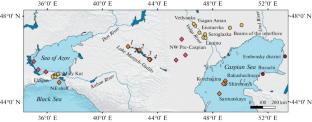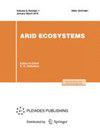末次冰期里海-曼奇-庞特水系孔雀鱼的生物多样性
摘要
摘要 确定了生物多样性形成的条件及其在 MIS 5 时代庞托-里海盆地各个发展阶段的比较分析。这项工作是在里海和亚速海-黑海地区以及曼伊奇洼地多年实地研究成果的基础上进行的。在 MIS 5 时代的气候条件下,里海-曼伊奇-庞特水系的孔雀鱼生物多样性与盆地的发展历史密不可分。在里海,重建了两个横跨流域:晚卡扎尔流域和希尔卡尼亚流域。古里海北部晚期哈扎里亚孔雀动物群有 26 个物种,其中主要是属于红心科的里海特有物种。索引物种为 Didacna surachanica Andrusov,1910 年。希尔卡尼亚孔雀动物群包括 22 个物种,其中大部分也是里海特有物种。特征类型为 Didacna subcatillus Andrusov, 1910 和 Didacna cristata Bogachev, 1932。孔雀鱼群的组成由以下主要因素决定:从以前流域继承的程度、水生环境的盐度和温度,以及随着河流径流引入的淡水动物。"随机 "灾难性因素的影响很大,如一个围冰期湖泊的决堤及其湖水流入里海,使海尔卡尼亚盆地的生物多样性与晚期卡扎尔盆地相比发生了急剧变化。在庞蒂亚盆地,卡朗加蒂断裂分三个阶段发展。庞提安盆地东北部的孔雀石类群由 37 个物种组成,其中主要是地中海海洋物种,既有极海洋物种,也有深海物种。每个阶段都有自己的水螅复合体,其中的极阴性或石炭酸性成分有不同程度的发展。第二个复合体对应于过渡的最大阶段,具有最丰富的多样性和最嗜卤的元素。第三个复合体的一个重要特征是存在里海海尔干年横断时期特有的里海物种。在 Manych 洼地,重建了与里海盆地和庞提安盆地的发展密切相关的事件:在庞提安盆地发展的第二阶段,卡朗加特断陷的海湾进入了里海盆地;海湾长度缩短,海尔干年断陷的海水同时推进并排入海湾;在发展的第三阶段,洼地完全脱离了卡朗加特水域,海尔干年断陷的海水排入了卡朗加特盆地。在庞提安盆地,物种多样性取决于从地中海迁移到这里的孔雀鱼群的组成。在卡兰加蒂大断代发展的最后阶段,其动物组成受到里海入侵物种的影响,这些物种随着希尔卡尼大断代的海水通过曼伊奇海峡进入庞蒂亚海盆。在里海,孔雀鱼群组成的形成主要是进化性质的。黑海孔雀鱼群的发展没有进化的成分;其形成具有迁移的性质。


The conditions for the formation of biodiversity and their comparative analysis at individual stages of development of the Ponto-Caspian basins in the MIS 5 era have been identified. This work was carried out based on the results of studying materials from many years of field research in the Caspian Sea and Sea of Azov–Black Sea regions and the Manych Depression. The biodiversity of malacofauna in the Caspian–Manych–Pont system under the climatic conditions of the MIS 5 era is inextricably linked with the history of the development of the basins. In the Caspian Sea, two transgressive basins have been reconstructed: the Late Khazarian and Hyrcanian. The Late Khazarian malacofauna of the northern part of the paleo-Caspian Sea is represented by 26 species, the main part of which are Caspian endemics belonging to the Cardiidae family. The index species is Didacna surachanica Andrusov, 1910. The Hyrcanian malacofauna includes 22 species, the main part of which are also Caspian endemics. Characteristic types are Didacna subcatillus Andrusov, 1910 and Didacna cristata Bogachev, 1932. The composition of the malacofauna was determined by the main factors: the degree of inheritance from the previous basin, the salinity and temperature of the aquatic environment, and the introduction of freshwater fauna with river runoff. The influence of “random” catastrophic factors, such as the breakthrough of a periglacial lake and the flow of its waters into the Caspian Sea, which sharply changed the biodiversity of the Hyrcanian basin compared to the Late Khazarian basin, is significant. In the Pontian basin, the Karangatian transgression developed in three stages. The malacofaunal composition in the northeastern part of the Pontian basin is represented by 37 species, the main part of which are marine Mediterranean species, both euryhaline and stenohaline. Each stage is characterized by its own complex of malacofauna with varying degrees of development of euryhaline or stenohaline elements in them. The second complex, corresponding to the maximum stage of transgression, was characterized by the greatest diversity and the presence of the most halophilic elements. An important feature of the third complex is the presence of Caspian species characteristic of the Hyrcanian transgression of the Caspian Sea. In the Manych Depression, events closely related to the development of the Caspian and Pontian basins were reconstructed: the ingression gulf of the Karangatian transgression of the Pontian basin in the second stage of its development; reduction in the length of the bay, with the simultaneous advance of waters of the Hyrcanian transgression and their discharge into the bay; complete release of the depression from the Karangatian waters and the discharge of the waters of the Hyrcanian transgression into the Karangatian basin in the third stage of development. In the Pontian basin, species diversity was determined by the composition of the malacofauna that migrated to it from the Mediterranean Sea. At the final stages of the development of the Karangatian transgression, its faunal composition was influenced by Caspian invasive species that penetrated into the Pontian basin with the waters of the Hyrcanian transgression through the Manych Strait. In the Caspian Sea, the formation of the malacofauna composition was predominantly evolutionary in nature. There was no evolutionary component in the development of the Black Sea malacofauna; its formation was of a migration nature.

 求助内容:
求助内容: 应助结果提醒方式:
应助结果提醒方式:


